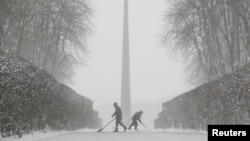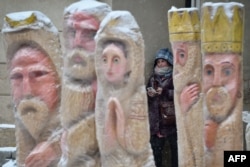Aid agencies report thousands of people in conflict-ridden Ukraine face a bleak Christmas and New Year because of freezing temperatures and shortages of essential goods.
Temperatures in Ukraine can plummet to minus 20 degrees Celsius in January. People throughout the country are suffering. But, those living in territory held by Russian-backed rebels in eastern Ukraine are most affected by the shortages brought on by nearly four years of war.
The U.N. refugee agency reports thousands of people displaced by conflict from their homes in the regions of Donetsk and Luhansk are having a tough time surviving. The situation is particularly difficult, it says, for people living near the contact line separating the government and rebel-controlled areas.
UNHCR spokesman Andre Mahecic says houses are frequently damaged by shelling. He says infrastructure is degraded and transport is bad, making it difficult for people to collect benefits, food and medicine.
“In some villages, the infrastructure, such as gas pipes have been damaged by shelling and, as a result, coal and firewood represent some sole means of heating the homes," says Mahecic. "Our staff report that the people are often forced to make choices between essentially buying food and medicines, or fuel to heat their homes.”
The UNHCR is providing aid to 15,300 of the most vulnerable people, including single parents, the elderly, families with many children and people with disabilities or chronic illnesses.
Most of the recipients are in the eastern non-government controlled areas where the situation is particularly critical. The UNHCR is stepping up the distribution of clothes, warm jackets and boots, coal for heating and cash grants to cover winter expenses.
In government-controlled areas, the agency’s aid consists of unconditional cash grants to 1,000 households and winter jackets to more than 4,700 children.










